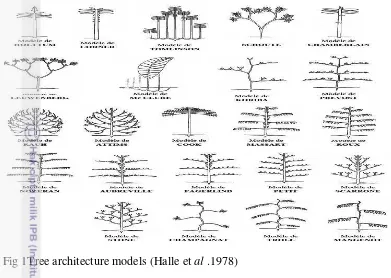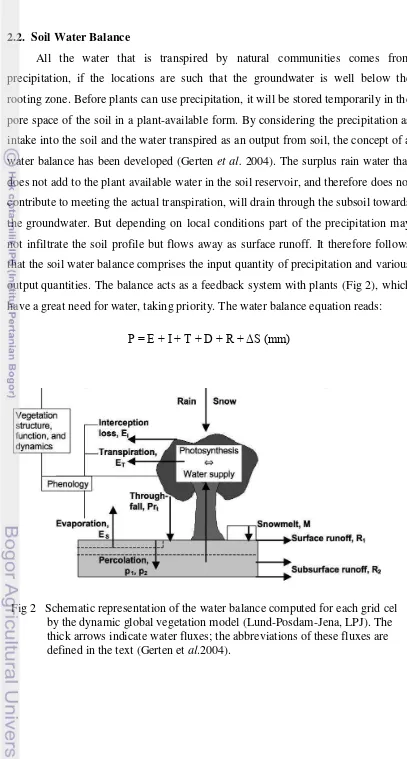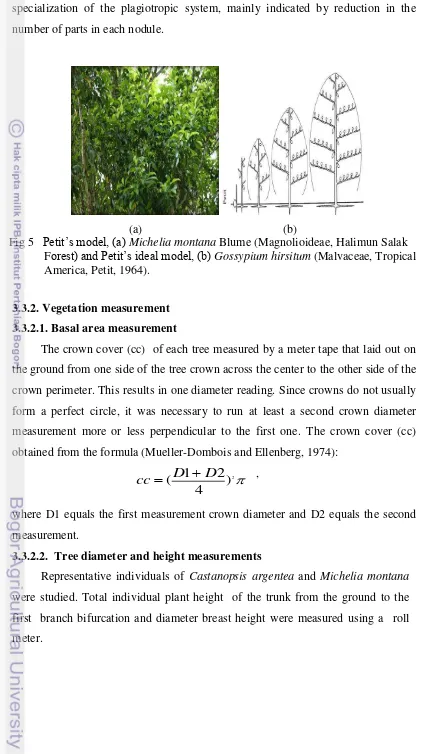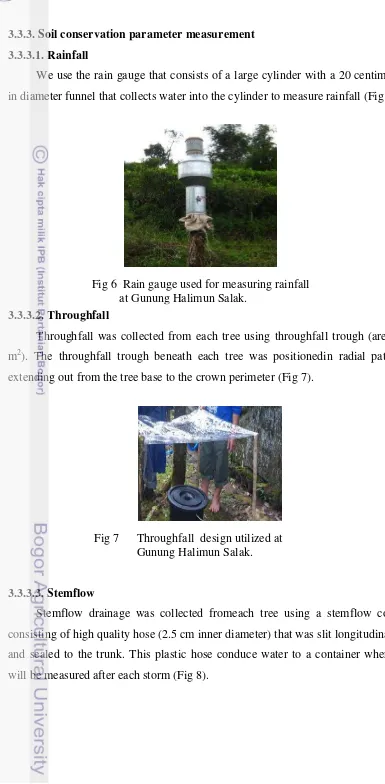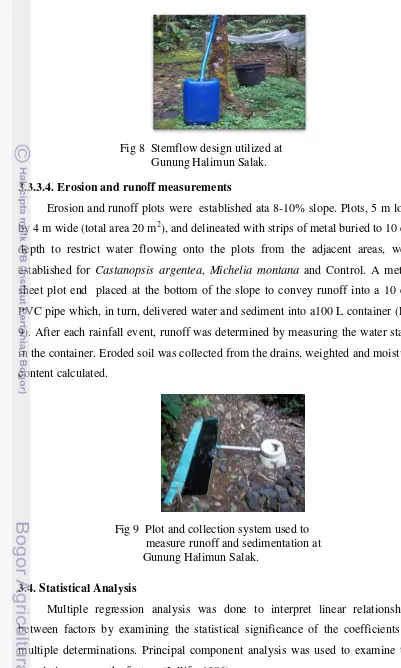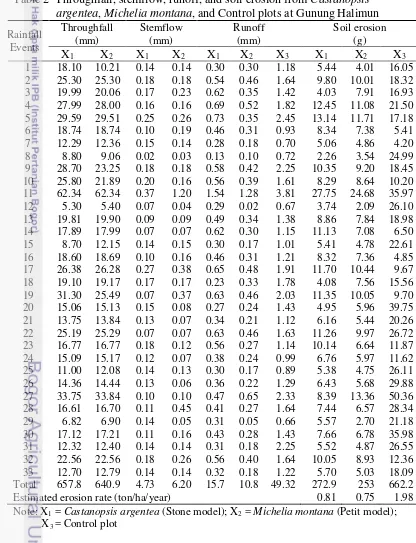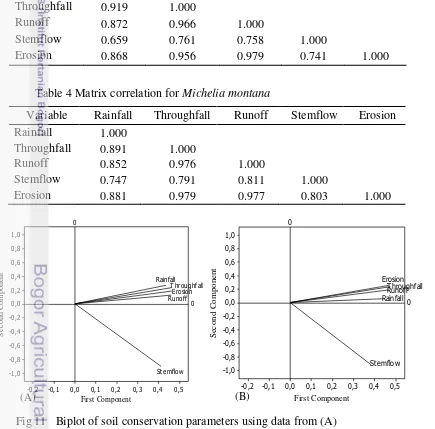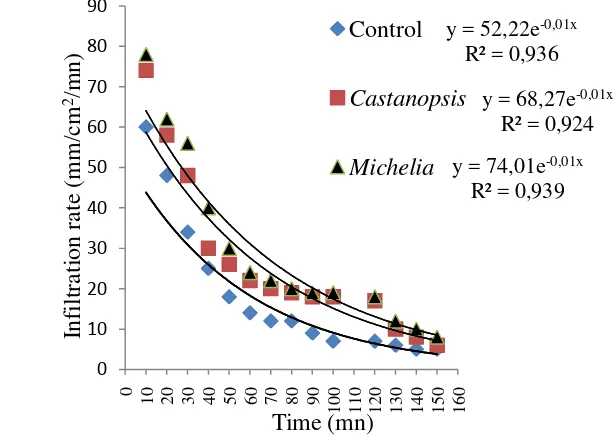CORRELATION BETWEEN TREE ARCHITECTURE
MODELS, SOIL AND WATER CONSERVATION AT
GUNUNG HALIMUN-SALAK NATIONAL PARK
SANOU FAYE
GRADUATE SCHOOL
BOGOR AGRICULTURAL UNIVERSITY
BOGOR
DECLARATION
I declare that this thesis titled “Correlation between tree architecture models, soil and water conservation at gunung halimun-salak national park.” was entirely completed by myself with resourceful help from the Department of Plant Biology, Bogor Agricultural University. Information and quotes which were sourced from journals and books have been acknowledged and mentioned where in the thesis they appear. All complete references are given at the end of the paper.
Bogor, July 2011
ABSTRACT
SANOU FAYE. G353098311. Correlation between Tree Architecture Models, Soil and Water Conservation at Gunung Halimun-Salak National Park. (Under supervision of DEDE SETIADI and IBNUL QAYIM)
Soil erosion by water is a worldwide environmental problem which degrades soil productivity and water quality. This research was conducted to find out how tree architecture models influence stemflow, throughfall, infiltration, surface runoff and erosion. The sample of the research was two trees at sub-montane zone Castanopsis argentea BI.with Stone‟s model and Michelia montana Blume. with Petit‟s model. Soil conservation parameter measured for stemflow, throughfall, infiltration, surface runoff and erosion. Multiple linear regression and principal component analyses were used to get the correlation of each parameter. Correlation of the two models Stone and Petit is nearly pursuant to value of stemflow. Stemflow of Stone model (4.73 mm) is slightly smaller than Petit‟s model (6.20 mm). The two models showed also tighter correlation pursuant to value of throughfall, which indicates 657.82 and 640.91 mm for Stone‟s model and Petit‟s model respectively. Runoff estimated was 15.74 and 10.87 mm for the same models. The two models Stone and Petit reduced runoff by 31.33 % and 45.37 %, respectively, as compared to the control surface. Similarly, soil loss was quantified in 1.98, 0.82 and 0.76 ton ha-1year-1 for the Control, Stone model and Petit models, respectively. Above results show that Michelia Montana Blume. is better than Castanopsis argentea BI. to be developed in soil and water conservation.
Keywords: tree architecture stone and petit models, stemflow, throughfall,
ABSTRAK
SANOU FAYE. G353098311. Korelasi Model Arsitektur Pohon dengan Konservasi tanah dan air di Taman Nasional Gunung Halimun Salak. (Dibimbing oleh DEDE SETIADI dan IBNUL QAYIM)
Erosi tanah merupakan salah satu masalah ekologi yang berkaitan dengan
konservasi tanah dan air. Penelitian ini bertujuan untuk mengetahui pengaruh model arsitektur terhadap aliran batang, curahan tajuk, aliran permukaan dan erosi. Sampel pada penelitian adalah dua pohon sub-montana yaitu Castanopsis argéntea dengan model Rauh dan Michelia montana dengan model Petit. Parameter konservasi tanah yang diukur adalah aliran batang, curahan tajuk, infiltrasi, aliran permukaan dan erosi. Regresi berganda dan analisis komponen utama digunakan untuk menentukan korelasi antara parameter. Korelasi pada kedua model mendekati untuk aliran batang. Aliran batang pada model Stone (4,73 mm) lebih kecil dibandingkan dengan model Petit (6,20 mm). Kedua model menunjukkan juga pola curahan tajuk yang sama. Curahan tajuk (640,91 mm) pada model Stone lebih kecil dibandingkan dengan Curahan tajuk model Petit (657,82 mm). Aliran permukaan pada model Petit (10,87mm) lebih kecil dibandingkan dengan model Rauh (15,74 mm). Kedua model Stone dan Petit masing-masing mampu reduksikan 31,33% dan 45,37% aliran permukaan dibandingkan kontrolnya. Demikian pula erosi tanah pada model Petit (0,76 ton/ha/tahun) adalah yang paling kecil dibandingkan dengan model Stone (0,82 ton/ha/tahun) dan Kontrol (1,98 ton/ha/tahun). Hasil di atas menunjukkan bahwa Michelia montana Blume.dengan model arsitektur Petit lebih baik daripada Castanopsis argentea BI dengan model arsitektur Stone untuk mendukung usaha
konservasi tanah dan air.
SUMMARY
SANOU FAYE. G353098311
. Correlation between Tree Architecture Models, Soil and Water Conservation at Gunung Halimun-Salak National Park. (Under supervision of DEDE SETIADI and IBNUL QAYIM)Soil erosion by water is a worldwide environmental problem which degrades soil productivity and water quality, causing a 17% reduction in crop production (Oldeman et al. 2003). Subsequent studies have shown that tree architecture models are a useful tool in water regulation, soil protection and conservation in different
natural ecosystems. However, few studies were conducted at individual plant scale (De Baets et al. 2007), on which we could relate such effects to the tree architecture
model and thereby provide necessary information to select suitable plant species for vegetation restoration. Model of tree architecture affect the amount of throughfall, stemflow and rainfall interception, each of which affect the runoff and soil erosion.
This study aims to determine the influence of tree architecture models Stone for Castanopsis argentea and Petit for Michelia Montana on stemflow, throughfall, surface runoff, infiltration, as well as on erosion and soil physical property at the Gunung Halimun Salak National Park. The research was done at Cikaniki research station and its surrounding areas, from 23 November 2010 to 20 January 2011.
Materials used include plant species Castanopsis argentea and Michelia montana, Global Position System (GPS), altimeter, clinometer, roll meter, rain gauge, containers, pvc pipe, analytical balance, camera, an equipment for soil sampling and soil gravimetric process in laboratory.
Description of the tree architecture models based on the type of branching and canopy shape. We use the common rain gauge that consists of a large cylinder with a 20 centimeter in diameter funnel that collects water into the cylinder to measure rainfall. The method used in measurement of throughfall and stemflow
gauges are made simple manually. Throughfall was collected from each tree using throughfall trough (area=1 m2). The throughfall trough beneath each tree was
of high quality hose (2.5 cm inner diameter) that was slit longitudinally and sealed to the trunk. This plastic hose conduce water to a container where it will be measured after each storm.
Erosion and runoff plots were established at a 8-10% slope. Plots, 5 m long by 4 m wide (total area 20 m2), and delineated with strips of metal buried to 10 cm depth to restrict water flowing onto the plots from the adjacent areas, were established for Castanopsis argentea, Michelia montana and the Control. A metal-sheet plot end placed at the bottom of the slope to convey runoff into a 10 cm PVC pipe which, in turn, delivered water and sediment into a100 L container. After each rainfall event, runoff was determined by measuring the water stage in the container. Eroded soil was collected from the drains, weighted and moisture content calculated.
Multiple regression analysis was done to interpret linear relationships between factors by examining the statistical significance of the coefficients of multiple determinations. Principal component analysis was used to examine the correlation among the factors (Jollife, 1986).
During the study period, fifty total rainfall events were registered, accounting for a total rainfall amount of 952.77 mm.This large water yield from Gunung Halimun Salak National Park illustrates that tropical rainforests usually receive
considerably more rainfall compared to other biomes.
Measurements of stemflow and throughfall were found to represent 0.5 and 77.96% for Castanopsis argentea with Stone‟s model, 0.7 and 80.02% for Michelia montana with Petit‟s model, respectively of the cumulative precipitation input. Throughfall and stemflow importance varie from the total incident precipitation, depending on branch and stand morphology and on bark roughness.
be higher with Castanopsis argentea and Michelia Montana compared to the Control plot. Michelia Montana and Castanopsis argentea are likely to release more litterfall that increased amounts of carbon, nitrogen, and phosphorus into the soil community and promote rainfall infiltration into the soil and reduces overland flow velocities, thus diminishing the soil erosion potential. However, contribution of these major categories of inputs from the canopy occurs with differences among tree species, and even among canopy layers. Michelia montana more highly branched with a shell of drooping leaves on the outside of the crown appeared more efficient at intercepting the larger amounts of rainfall.
Soil conservation parameters are positively correlated with tree architecture Stone‟s model for Castanopsis argentea and Petit‟s model for Michelia.The relative correlation of each variable demonstrated clearly that throughfall and runoff are far more correlated with soil erosion than rainfall and stemflow. Total runoff measured was 49.32 mm for the Control, 15.74mm for Castanopsis argentea with Stone‟s model and 10.87 mm for Michelia Montana with Petit‟s model. The two models Stone and Petit reduced runoff by 31.33 % and 45.37 %, respectively, as compared to the control surface. Cumulative soil loss values were quantified in 1.98 ton ha -1
year-1for the Control, 0.82 for Castanopsis argentea with architecture Stone‟s model and 0.76 for Michelia Montana with architecture Petit‟s model.
© Copyright of IPB, year 2011 Copyright reserved
1. Forbidden to quote part or all of these writings without including or mentioning the source.
a. Be cited only for educational purposes, research, writing papers, drafting reports, writing criticism or review an issue;
b. Quotation must not harm the affairs of IPB.
2. Prohibit publication and reproduction of part or all of the paper in any
CORRELATION BETWEEN TREE ARCHITECTURE
MODELS, SOIL AND WATER CONSERVATION AT
GUNUNG HALIMUN-SALAK NATIONAL PARK
SANOU FAYE
A Thesis
As Partial fulfillment of the Requirement to obtain Master of Science Degree in Plant Biology
GRADUATE SCHOOL
BOGOR AGRICULTURAL UNIVERSITY
BOGOR
Title : Correlation between Tree Architecture Models, Soil and Water Conservation at Gunung Halimun-Salak National Park
Name : Sanou Faye
Registration Number : G353098311
Major : Plant Biology
Approved: Advisory Committee
Prof. Dr. Ir. Dede Sediadi, MS. Dr.Ir. Ibnul Qayim
Chairman Member
Agreed:
Coordinator of Plant Biology Major Dean of Graduate School
Dr.Ir.Miftahudin,M.Si.Dr. Ir. Dahrul Syah, M.Sc.Agr
ACKNOWLEDGEMENT
My study and thesis research would not have been accomplished without the help of many people.
Special thanks to Prof. Dr. Ir. Dede Setiadi and Dr. Ir. Ibnul Qayim as supervisory committee, for all of guidance and encouragement as well as invaluable academic advices for the whole period of my study and research at IPB.
Special thanks also are to be given to the Department of Plant Biology for the full support given to enable the successful completion of this research. I am very grateful to all the invaluable lecturing staff as well as lab and technical staff of Plant Biology Department who have imparted knowledge and help.
Extended thanks are expressed to all fellow students of Plant Biology Department and KNB Scholarship. Of these fellows, I would like to express my deepest thanks to close friends Chea Sinath, Prima and Adi who always providing
a helping hand and good advices. I wholeheartedly thank to research team of plant architecture models such as Novi, Marina, and Rita, who made my master research a great experience of team working.
Further, I am highly indebted to my affectionate parents, brothers, sisters and other family members who always inspire and encourage me for higher education, and finally to Miss Jazy who contributes immensely in providing psychological supports and good constructed advice during busy time of my study and research.
The research was supported by Gunung Halimun-Salak staff, and additional funding was provided through my study sponsor-Dikti under Developing Countries Partnership Program.
Bogor, July 2011
BIOGRAPHY
TABLE OF CONTENTS
LIST OF TABLES ... xv
LIST OF FIGURES ... xvii
LIST OF APPENDIX ... xixii
I. INTRODUCTION ... 1
1.1. Background ... 1
1.2. Research Objective ... 2
1.3. Research Benefits ... 2
II. LITERATURE REVIEW ... 3
2.1. Tree Architecture Models ... 3
2.2. Soil Water Balance ... 5
2.3. Water Erosion ... 6
2.4. Factors Affecting Water Erosion ... 7
2.4.1. Climate ... 7
2.4.2. Topography ... 7
2.4.3. Plant cover ... 7
2.4.4. Soil properties ... 8
III. MATERIALS AND METHODS ... 9
3.1. Time and Place ... 9
3.2. Materials and Equipment ... 9
3.3. Methods ... 9
3.3.1. Tree architecture model identification ... 9
3.3.2. Vegetation measurement ... 11
3.3.3. Soil conservation parameter measurements ... 12
IV. RESULTS AND DISCUSSION ... 15
4.1. Tree characteristics ... 15
4.2. Soil Conservation Parameters ... 16
4.2.1. Rainfall ... 17
4.2.2. Throughfall and stemflow for the different plots ... 17
4.2.3. Erosion and runoff for the different plots ... 18
4.3. Correlation Between Soil Conservation Parameters ... 19
4.4. Infiltration rate for the different plots ... 21
V. CONCLUSION AND SUGGESTION ... 23
REFERENCES ... 25
LIST OF TABLES
Table 1 Plant species characteristics ... 15
Table 2 Throughfall, stemflow, runoff, and soil erosion from Castanopsis ... 16
Table 3Matrix correlation for Castanopsis argentea ... 20
LIST OF FIGURES
1Tree architecture models (Halle et al .1978) ... 4
2 Schematic representation of the water balance ... 5
3Particle detachment, transport and deposition on bare soil surface ... 6
4Stone‟s model... 10
5 Petit‟s model ... 11
6Rain gauge used for measuring rainfall ... 12
7Throughfall design utilized at ... 12
8Stemflow design utilized ... 13
9 Plot and collection system used to ... 13
10 Runoff relationship (A) and rainfall-erosion relationship (B) ... 19
11 Biplot of soil conservation parameters ... 20
LIST OF APPENDIX
I. INTRODUCTION
1.1. BackgroundSoil erosion by water is a serious and global environmental problem. About 85% of the land degradation in the world is associated with soil erosion, causing a
17% reduction in crop production (Oldeman et al. 2003). The problem of soil erosion is severe particularly in the tropics and sub-tropics where erosion rate range from 30 and 40 ton ha-1yr-1 (Pimentel, 2006).
Thus, soil erosion should be regarded as a natural disaster andcontrolled by appropriate measures. Many studies have proved increasing vegetation cover is an important measure to control water erosion, and to improve soil environments (Duran-Zuazo 2004; Xu et al. 2008). Quantitative and qualitative studies onthe role of forests in water regulation, protection and conservation in different naturalecosystems have been published in a related Thematic Study on Forestsand Water (FAO, 2010). These studies have suggested the influence exerted by the presence or absence of a good forest cover on regional climate (rainfall), total and seasonal water yield (floods, low flows), as well as on different forms of erosion and catchment sediment yield underhumid tropical conditions in general and in Southeast Asia in particular. However, only a few studies are related to the interaction among vegetation cover, soil physical conditions and the surface hydrological processes of soil erosion and runoff (Chen et al. 2007; Bautista et al. 2007), and even fewer at individual plant scale (De Baets et al. 2007), on which we could relate such effects to the tree architecture model and thereby provide
necessary information to select suitable plant species for vegetation restoration. Tree architecture models are a useful tool in the description of tropicaltrees
highlyefficient for light and rainfall interception in equitable environments ofthe humid tropics (Chazdon,1985; Ackerly and Bazzaz, 1995; Pearcy and Yang, 1996), but crown shape and branch proportions may vary widely within a particular architectural model (Fisher and Hibbs, 1982; Fisher, 1986).Branching patterns affect leaf display, efficiency of mechanical support andsupply of water.However, some workers stillhave questioned the value ofarchitectural models as a way of analyzing ecological roles.
1.2. Research Objective
The objective of the research was to find out the influence of Castanopsis argenteaBI.andMichelia montana Blume.architecturemodels on stemflow, throughfall, surface runoff, infiltration, as well as on erosion and soil physical property.
1.3. Research Benefits
This study is expected to provide information that accelerate restoration processes by focusing on selecting species that can effectively control water runoff and soil loss, as well as on designing effective vegetation restoration pattern.
Castanopsis argentea or saninten in local name has big nuts. The nuts only
fall after mature.Then there are many nuts under the mother trees. Many animals come to eatthe nuts. Castanopsis argentea trees are important food resource for animals.
II.
LITERATURE REVIEW
2.1. Tree Architecture ModelsTree architecture and its influence on whole-plant functionand forest processes have been approached from a variety ofperspectives, involving both the spatial arrangement ofleaves considered in physiological process models and thegenetically influenced programme of development consideredin morphological models (Room et al. 1994). The concept of architectural modeling is a dynamic one, since it refers to the genetic information which determines the succession of forms of the tree. In order to understand architectural models, one has to observe trees as individuals at different stages, including at least the earliest part of their life and in as aoptimal an environment as possible so that the model is expressed freely.
Building on previous morphological studies,Halle, Oldeman and Tomlinson (1978) proposed thattropical trees could be described in terms of 23 architecturalmodels(Fig 1), based on the behaviour of apical meristems inproducing
branching systems.According to this concept of „architectural analysis‟ each plant conforms throughoutitsontogeny to an architectural model that is anabstraction for the deterministic genetic blueprint on whichthe construction of the plant is based.
Fig 1Tree architecture models (Halle et al .1978)
Under optimalgrowth conditions, the development and architecture of theplant conform strictly to the model, but varied environmentalconditions and interactions with other organismsmay result in deviations from the model. Thus, most developmentalmorphologies of plants represent a balancebetween deterministic genetic and opportunistic environmentalevents (Hallé, 1999).
Recently, Robinson (1996) has usedsymbolic logic to represent and analyse the Halle´ and Oldeman system. Heinferred the possible existence of several, as yet,
unreported models.Many trees in the forest do not appear to conform to one of the 23 basicmodels, even when allowance is made for loss of branches due to damage
2.2. Soil Water Balance
All the water that is transpired by natural communities comes from precipitation, if the locations are such that the groundwater is well below the rooting zone. Before plants can use precipitation, it will be stored temporarily in the pore space of the soil in a plant-available form. By considering the precipitation as intake into the soil and the water transpired as an output from soil, the concept of a water balance has been developed (Gerten et al. 2004). The surplus rain water that does not add to the plant available water in the soil reservoir, and therefore does not contribute to meeting the actual transpiration, will drain through the subsoil towards the groundwater. But depending on local conditions part of the precipitation may not infiltrate the soil profile but flows away as surface runoff. It therefore follows that the soil water balance comprises the input quantity of precipitation and various output quantities. The balance acts as a feedback system with plants (Fig 2), which have a great need for water, taking priority. The water balance equation reads:
[image:35.595.106.513.55.814.2]P = E + I + T + D + R + ΔS (mm)
The P stands for precipitation, E for evaporation (the unproductive loss of water from the soil surface to the atmosphere), I for interception (the evaporative loss to the atmosphere of precipitation that was retained on leaf surfaces), T for transpiration (the productive loss of water by the plants to the atmosphere via stomates), D for subsoil drainage, R for runoff and ΔS for change in soil water storage. The change may be positive (gain of soil water) or may be negative (loss of moisture from the soil profile). All the terms listed are considered for specified time intervals, i.e. days, months or years.
Quite frequently the terms E and T are put together. ET, the evapo-transpiration, is often used, as it is quite troublesome to separate E and T when measuring the balance in the a field. Also the interception, I, is usually not recorded as a separate term, and therefore is often included in ET.
2.3. Water Erosion
On a global scale, water erosion is the most severe type of soil erosion. Rain-splash and running water are two of the most important detaching agents that remove soil particles from soil surface. Detached soil particles are transported by running water (Fig 3). When sufficient energy is no longer available to transport soil particles, a third phase, deposition, occurs.
According to previous studies, relevant variables for soil erosion can be grouped into rainfall impact, flow characteristics, and bed conditions (ICHE 2006).
2.4. Factors Affecting Water Erosion
2.4.1. Climate
All climatic factors (precipitation, humidity, temperature, evapo-transpiration, solar radiation, and wind velocity) affect water erosion. Precipitation is the main agent of water erosion. Amount, intensity, and frequency of precipitation determine the magnitude of erosion. Intensity of rain is the most critical factor. The more intense the rainstorm, the greater the runoff and soil loss. High temperature may reduce water erosion by increasing evapotranspiration and reducing the soil water content. High air humidity is associated with higher soil water content. Higher winds increase soil water depletion and reduce water erosion.
2.4.2. Topography
Soil erosion increases with increase in field slope. Soil topography determines the velocity at which water runs off the field. The runoff transport capacity increases with increase in slope steepness. Soils on convex fields are more readily eroded than in concave areas due to interaction with surface creeping of soil by gravity. Degree, length, and size of slope determine the rate of surface runoff. Rill, gully, and stream channel erosion are typical of sloping watersheds. Steeper terrain
slopes are prone to mudflow erosion and landslides.
2.4.3. Plant cover
Moreover, the litterfall of native vegetation mulches prevented the direct impact of raindrops on bare soil and thus decreased surface sealing and lengthened the residence time for water to infiltrate into the soil (Bhatt and Khera 2006).
Plant strips protected soil from the erosive action of runoff water, by offering resistance to the movement of water and shielding the soil from such effects. The plant strips also interrupted raindrop splash and overland flow, thereby reducing erosion. Francia et al. (2006) and Martinez et al. (2006) reported that plant strips efficiently buffered the mechanical impact of the raindrops on the soil surface, diminishing runoff. Duran zuazo et al. (2009) reported that more soil erosion and runoff were registered in the Non-tillage without plant strips (NT) compared to the Non-tillage with native vegetation strips (NVS) treatment in olive orchards.
The plant roots penetrating the soil matrix favoured porosity and thus infiltration, allowing the root zone to act as a partial sink for runoff. Root species that deployed their roots mainly in the topsoil helped reduce soil erosion by bolstering soil shear strength, while the increased root density with higher species numbers enhanced soil antiscourability (Francia et al. 2006; Martinez et al. 2006). The differences were clearly visible in the field-both the roots and stems increased the roughness of the soil surface and thus soil permeability, improving infiltration and avoiding soil disturbance treatment with detached soil particles.
2.4.4. Soil properties
III. MATERIALS AND METHODS
3.1. Time and PlaceThe research was done atCikaniki research station and its surrounding areas, GunungHalimun-Salak National Park from 23 November 2010 to 20 January 2011.
3.2. Materials and Equipment
Materials used include plant species Castanopsis argentea and Michelia montana, Global Position System (GPS), altimeter, clinometer, roll meter, rain gauge, containers, pvc pipe, analytical balance, camera, an equipment for soil sampling and soil gravimetric process in laboratory.
3.3. Methods
3.3.1. Tree architecture model identification
Architectural models are recognized mainly by criteria which relate to primary growth. Radial growth from a vascular cambium which brings about secondary increase in thickness serves to stabilize the primary system. In this study,
two architecture models we have so far recognized are Stone and Petit models. Earch architectural model is named after we have examined in greater or lesser details and are based on field notes and sketches supplemented by photographs on the plant exhibiting the model. A description and short definition of the two architecture models have been done. In addition each model is illustrated initially by species which show the model well.
3.3.1.1. Stone’s model
3.3.1.2. Petit’s model
The model named after E. Petit, who has contributed to the understanding of the architecture trees in his study of Africa Rubiaceae belonging to the tribe
Gardenieae (Petit, 1964). Many of the trees which conform to this model are small and there is a high degree of reduction in the organization of their branch modules. The model is illustrated initially by Gossypium hirsutum (Malvaceae, Tropical
America) widely cultivated as one of the commercial cottons. The architecture of the tree is determined by the continuous growth of a monopodial, orthotropic trunk axis which produces, either continuously or in a diffuse manner, plagiotropic branches with spiral or decussate phyllotaxis. In many examples this continuous growth, once branch initiation has begun, results in continuous branching, i.e., a branch at every node on the trunk. Branches are modular, plagiotropic by substitution, each module being hapaxanthic. Large trees may conform to Petit‟s model, as is indicated by Michelia montana Blume. (Fig 5), a common tree of the Gunung Halimun Salak Forest which reaches a height of 10 to 20 m. All parts of the plant are big and leaves are arranged throughout. This tree is most characteristic of steep hillsides where large populations of young, suppressed trees may occur. Trees which conform to this model occupy a wide variety of habits, ranging from the lowest to the higher levels of rain-forest, but also in savana, even in quite dry places. The main biological feature in this model is the strong tendency towards
(a) (b)
Fig 4 Stone‟s model, (a) Castanopsis argentea (Fagaceae, Halimun-Salak Forest) and Stone‟s ideal model, (b) Pandanus pulcher (Pandanaceae, endemic to
(a) (b)
Fig 5 Petit‟s model, (a) Michelia montana Blume (Magnolioideae, Halimun Salak Forest) and Petit‟s ideal model, (b) Gossypium hirsitum (Malvaceae, Tropical America, Petit, 1964).
specialization of the plagiotropic system, mainly indicated by reduction in the number of parts in each nodule.
3.3.2. Vegetation measurement 3.3.2.1. Basal area measurement
The crown cover (cc) of each tree measured by a meter tape that laid out on the ground from one side of the tree crown across the center to the other side of the crown perimeter. This results in one diameter reading. Since crowns do not usually form a perfect circle, it was necessary to run at least a second crown diameter measurement more or less perpendicular to the first one. The crown cover (cc) obtained from the formula (Mueller-Dombois and Ellenberg, 1974):
,
where D1 equals the first measurement crown diameter and D2 equals the second measurement.
3.3.2.2. Tree diameter and height measurements
Representative individuals of Castanopsis argentea and Michelia montana were studied. Total individual plant height of the trunk from the ground to the first branch bifurcation and diameter breast height were measured using a roll meter.
2 ) 42 1
(D D
3.3.3. Soil conservation parameter measurement 3.3.3.1. Rainfall
We use the rain gauge that consists of a large cylinder with a 20 centimeter in diameter funnel that collects water into the cylinder to measure rainfall (Fig 6).
3.3.3.2. Throughfall
Throughfall was collected from each tree using throughfall trough (area=1 m2). The throughfall trough beneath each tree was positionedin radial pattern extending out from the tree base to the crown perimeter (Fig 7).
3.3.3.3. Stemflow
[image:42.595.77.462.58.842.2]Stemflow drainage was collected fromeach tree using a stemflow collar consisting of high quality hose (2.5 cm inner diameter) that was slit longitudinally and sealed to the trunk. This plastic hose conduce water to a container where it will be measured after each storm (Fig 8).
Fig 6 Rain gauge used for measuring rainfall at Gunung Halimun Salak.
3.3.3.4. Erosion and runoff measurements
Erosion and runoff plots were established ata 8-10% slope. Plots, 5 m long by 4 m wide (total area 20 m2), and delineated with strips of metal buried to 10 cm depth to restrict water flowing onto the plots from the adjacent areas, were established for Castanopsis argentea, Michelia montana and Control. A metal-sheet plot end placed at the bottom of the slope to convey runoff into a 10 cm PVC pipe which, in turn, delivered water and sediment into a100 L container (Fig 9). After each rainfall event, runoff was determined by measuring the water stage in the container. Eroded soil was collected from the drains, weighted and moisture content calculated.
3.4. Statistical Analysis
Multiple regression analysis was done to interpret linear relationships between factors by examining the statistical significance of the coefficients of multiple determinations. Principal component analysis was used to examine the correlation among the factors (Jollife, 1986).
[image:43.595.95.496.59.727.2]Fig 8 Stemflow design utilized at Gunung Halimun Salak.
IV.
RESULTS AND DISCUSSION
4.1. Tree characteristics
Throughfall, stemflow, runoff and soil erosion were collected during the study period from Castanopsis argentea and Michelia montana which represent
common canopy tree species at Gunung Halimun Salak National Park.
Castanopsis argentea (Fagaceae) saninten in local name is one of the most
dominant species around Cikaniki. Fagaceae is one of the most dominant trees on tropical mountain forest.
Michelia montana belongs to the Magnoliaceae‟s family. Magnoliaceae is familiar plants for people in Gunung Halimun Salak National Park. Though most magnolia in cool climate are deciduous, those in tropical forests are evergreen. In nature the tree can reach 50 m high with a trunk diameter of 1.8 m.
In Indonesia this species distributes in Sumatra, Jawa, Sulawesi and Lesser Sunda islands. It grows at an altitude of 250-1500 m above sea level (Oyen and Dung, 1999), at climate type A or B according to Smith and Ferguson classification with rainfall ranging from 1000 to 2000 mm/year (Saputra, 1991 in Iskandar, 2003). In Java, Michelia montana cultivation is carried out on land up to about 1200 m above sea level (Heyne, 1987). Michelia montana grows well in soils dominated by clay, slightly moist soil conditions and normal pH (Iskandar, 2003).
In this study, each species was represented by one canopy tree having crown fully exposed to vertical rainfall inputs. Full characteristics of the selected trees
are shown in Table 1. The forest floor of each of these trees is covered by Pinanga coronata, Angiopteris, Cyathea, Rottans. The trees have many epyphytes of
orchids, ferns (Aslpenium nidus, Drynaria, Nephrolepis), and Freycinetia.
Table 1 Plant species characteristics
Plant Species Plot Area (m2)
Crown Cover
(m2)
Trunk Diameter (cm) Total Height (m) Architecture Model
4.2. Soil Conservation Parameters
[image:46.595.83.499.220.763.2]Soil conservation parameter measurements at each plot were made over the study period between November 2010 and January 2011. Throughfall, stemflow, runoff, and soil erosion measurements from Castanopsis argentea, Michelia montana, and Control plots are presented in Table 2.
Table 2 Throughfall, stemflow, runoff, and soil erosion from Castanopsis argentea, Michelia montana, and Control plots at Gunung Halimun
Rainfall Events Throughfall (mm) Stemflow (mm) Runoff (mm) Soil erosion (g)
X1 X2 X1 X2 X1 X2 X3 X1 X2 X3
1 18.10 10.21 0.14 0.14 0.30 0.30 1.18 5.44 4.01 16.05
2 25.30 25.30 0.18 0.18 0.54 0.46 1.64 9.80 10.01 18.32
3 19.99 20.06 0.17 0.23 0.62 0.35 1.42 4.03 7.91 16.93
4 27.99 28.00 0.16 0.16 0.69 0.52 1.82 12.45 11.08 21.50
5 29.59 29.51 0.25 0.26 0.73 0.35 2.45 13.14 11.71 17.18
6 18.74 18.74 0.10 0.19 0.46 0.31 0.93 8.34 7.38 5.41
7 12.29 12.36 0.15 0.14 0.28 0.18 0.70 5.06 4.86 4.20
8 8.80 9.06 0.02 0.03 0.13 0.10 0.72 2.26 3.54 24.99
9 28.70 23.25 0.18 0.18 0.58 0.42 2.25 10.35 9.20 18.45
10 25.80 21.89 0.20 0.16 0.56 0.39 1.61 8.29 8.64 10.20
11 62.34 62.34 0.37 1.20 1.54 1.28 3.81 27.75 24.68 35.97
12 5.30 5.40 0.07 0.04 0.29 0.02 0.67 3.74 2.09 26.10
13 19.81 19.90 0.09 0.09 0.49 0.34 1.38 8.86 7.84 18.98
14 17.89 17.99 0.07 0.07 0.62 0.30 1.15 11.13 7.08 6.50
15 8.70 12.15 0.14 0.15 0.30 0.17 1.01 5.41 4.78 22.61
16 18.60 18.69 0.10 0.16 0.46 0.31 1.21 8.32 7.36 4.85
17 26.38 26.28 0.27 0.38 0.65 0.48 1.91 11.70 10.44 9.67
18 19.10 19.17 0.17 0.17 0.23 0.33 1.78 4.08 7.56 15.56
19 31.30 25.49 0.07 0.37 0.63 0.46 2.03 11.35 10.05 9.70
20 15.06 15.13 0.15 0.08 0.27 0.24 1.43 4.95 5.96 39.75
21 13.75 13.84 0.13 0.07 0.34 0.21 1.12 6.16 5.44 20.26
22 25.19 25.29 0.07 0.07 0.63 0.46 1.63 11.26 9.97 26.72
23 16.77 16.77 0.18 0.12 0.56 0.27 1.14 10.14 6.64 11.87
24 15.09 15.17 0.12 0.07 0.38 0.24 0.99 6.76 5.97 11.62
25 11.00 12.08 0.14 0.13 0.30 0.17 0.89 5.38 4.75 26.11
26 14.36 14.44 0.13 0.06 0.36 0.22 1.29 6.43 5.68 29.88
27 33.75 33.84 0.10 0.10 0.47 0.65 2.33 8.39 13.36 50.36
28 16.61 16.70 0.11 0.45 0.41 0.27 1.64 7.44 6.57 28.34
29 6.82 6.90 0.14 0.05 0.31 0.05 0.66 5.57 2.70 21.18
30 17.12 17.21 0.11 0.16 0.43 0.28 1.43 7.66 6.78 35.98
31 12.32 12.40 0.14 0.14 0.31 0.18 2.25 5.52 4.87 26.55
32 22.56 22.56 0.18 0.26 0.56 0.40 1.64 10.05 8.93 12.36
33 12.70 12.79 0.14 0.14 0.32 0.18 1.22 5.70 5.03 18.09
Total 657.8 640.9 4.73 6.20 15.7 10.8 49.32 272.9 253 662.2
Estimated erosion rate (ton/ha/year) 0.81 0.75 1.98
4.2.1. Rainfall
Fifty total rainfall events were registered during the study period starting from 23 November 2010 to 20 January 2011, accounting for a total rainfall amount of 952.77 mm. Thirty three runoff-producing events, accounting for a total amount 822 mm were evaluated. More than 87% of the raindays had gross rainfall totals of more than 8 mm day-1, ranging from 8.22 to 63.51 mm day-1. This large water yield illustrates that the climate, as Gunung Halimun National Park in general, belong to type A of Schmidt and Ferguson (1951) classification with the annual rainfall of 4000-6000 mm. Similarly high yields have been reported for other montane forests. For instance, the tropical forests on Barro Colorado Island, Panama, receive on average 2612 mm of rainfall annually (Windsor 1990). Rainforests are one of the most efficient systems for retaining and recirculating freshwater on the planet. In general, tropical rainforests usually receive considerably more rainfall compared to other biomes.
However, such forests are potentially under threat from climate change, which could result in reduced cloud water interception and improved conditions for evaporation.The net effect of these changes is reduced yield, which is important hydrologically, and altered moisture conditions,which could also be disastrous for plant and animal species dependent on wet and humid conditions.
4.2.2. Throughfall and stemflow for the different plots
throughfall (%) values reported by Navar et al. (1999) for six study plots within the Northern Gulf of Mexico Coastal Plain (73.4-83.7%). Cumulative stemflow (%) generated, although not significantly different, is similarr to the average values observed by Navar et al.(1999) (0.4-6.5%). Other observations have been made for other montane rainforests. At the Australian tropical rainforest, McJannet et al. (2007) reported 65% (3739 mm) and 7% (418 mm) of gross precipitation for throughfall and stemflow respectively. The significant discrepancy between these findings warrants further attention. Throughfall and stemflow importance varie from the total incident precipitation, depending on branch and stand morphology and on bark roughness.
In this study, comparison of the two species of tree indicated the importance of crown form. Michelia Montana was found in site with more direct overhead rainfall interception on average than Castanopsis argentea, generallysmall leaves in the canopy. Michelia Montana was more highly branched with a shell of drooping leaves on the outside of the crown. Castanopsis argentea had whorle branches in tiers with planar foliage arrays. Michelia montana appeared moreefficient at intercepting the larger amounts of rainfall available in rain forest understorey sites.
4.2.3. Erosion and runoff for the different plots
Mexico. Nevertheless, the value for the Control plot was lower than those reported by the same authors (0.33).
It was observed that an increase in rainfall did not produce an increment in runoff for the patches of Castanopsis argentea and Michelia montana likely the Control (Fig 10). Given the leaf area index and woody surface area index that characterize Castanopsis argentea and Michelia montana, the probability of a raindrop passing through the canopy without contacting a vegetative surface is relatively low even under strong wind conditions. The aerial structures of the two species intercept a significant amount of rainfall, which is subsequently translocated as stemflow to the soil,increasing infiltration and diminishing the potential for runoff. Cumulative soil loss values were quantified in 1.98, 0.82 and 0.76 ton ha-1year-1 for the Control, Castanopsis argentea and Michelia montana, respectively. Increases in the amount of surface runoff lead to an increase in soil erosion. However, these relationships are inconsistent in Castanopsis argentea and Michelia montana plot. This result suggests that vegetation patches of Castanopsis argentea and Michelia montana create soil fertility where soil organic matter contents are greater, bulk densities are lower, and consequently, the stability of aggregates and water intake increases, reducing the amount of runoff and soil erosion.
4.3. Correlation BetweenSoil Conservation Parameters
Linear multiple regressions onto rainfall, throughfall, stemflow, runoff and erosion are computed:
Fig 10 Runoff relationship (A) and rainfall-erosion relationship (B) for different plots. 0,0 0,5 1,0 1,5 2,0 2,5 3,0 0 5
10 15 20 25 30 35 40 45 50 55 60 65 70
S oil e rosion ra te ( g /m 2) Rainfall (mm)
Castanopsis Michelia Control
(A) 0 1 2 3 4 0 5
10 15 20 25 30 35 40 45 50 55 60 65 70
R
unof
f
(mm)
Rainfall (mm)
Castanopsis Michelia Control
Erosion(Castanopsis) = 0.02 + 0.004 rainfall + 0.06 throughfall + 14.8 runoff -0.4 stemflow
Erosion(Michelia) = 0.65 +0.03 rainfall + 0.16throughfall + 8.76 runoff + 0.34 stemflow
The coefficients of multiple determination (R2 = 0.961 and 0.97) are high which, given r = 0.98, is significant (P<0.01). This indicates that soil erosion is significantly correlated to rainfall, throughfall, stemflow and runoff. These correlations are summarized in Tables 3 and 4 and the results of the Principal components analysis (PCA) are showed in the biplot (Fig 11).
Table 3 Matrix correlation for Castanopsis argentea
Variable Rainfall Throughfall Runoff Stemflow Erosion Rainfall 1.000
Throughfall 0.919 1.000
Runoff 0.872 0.966 1.000
Stemflow 0.659 0.761 0.758 1.000
[image:50.595.77.512.317.746.2]Erosion 0.868 0.956 0.979 0.741 1.000
Table 4 Matrix correlation for Michelia montana
Variable Rainfall Throughfall Runoff Stemflow Erosion Rainfall 1.000
Throughfall 0.891 1.000
Runoff 0.852 0.976 1.000
Stemflow 0.747 0.791 0.811 1.000
Erosion 0.881 0.979 0.977 0.803 1.000
0,5 0,4 0,3 0,2 0,1 0,0 -0,1 -0,2 1,0 0,8 0,6 0,4 0,2 0,0 -0,2 -0,4 -0,6 -0,8 -1,0 First Component S e c o n d C om p o ne n t 0 0 Erosion Stemflow Runoff Throughfall Rainfall 0,5 0,4 0,3 0,2 0,1 0,0 -0,1 -0,2 1,0 0,8 0,6 0,4 0,2 0,0 -0,2 -0,4 -0,6 -0,8 -1,0 First Component S e c o nd C o m po n e n t 0 0 Erosion Stemflow Runoff Throughfall Rainfall
Fig 11 Biplot of soil conservation parameters using data from (A) Castanopsis argentea and (B) Michelia montana.
The biplots display graphically the five variables within a coordinate system
where the relative positions of the variables reflect correlations. The relative correlation of each variable demonstrated clearly that throughfall and runoff are far more correlated with soil erosion than rainfall and stemflow. Interpretation of this ordination is that the volume of rainfallper unit projected crown area from the same rainfall eventis primarily in the form of throughfall and stemflow, with relative contribution of throughfall to runoff being somewhat more important. In fact, since runoff and erosion are measured in the same unit data, the three variables throughfall, runoff and erosion were found to be more correlated than rainfall and stemflow.
Compared to throughfall, stemflowrepresented a small component of theprecipitation flux and its contribution to runoff seems to be very small. Moreover, the average Herwitz(1986) funnelling ratio derived for woody stem plants suggests that stemflow is an important water flux, delivering an average of 21times more water to the base of the plant than to runoff flux.
4.4. Infiltration rate for the different plots
[image:51.595.156.463.490.711.2]In addition to vegetation observations, experimental measurements of infiltration were made. The infiltration rate curves are presented in Fig 12.
Fig 12 Infiltration rate cuves for Castanopsis argentea, Michelia montana and Control plots.
y = 52,22e-0,01x R² = 0,936
y = 68,27e-0,01x R² = 0,924
y = 74,01e-0,01x R² = 0,939
0 10 20 30 40 50 60 70 80 90
0 10 20 30 40 50 60 70 80 90
100 110 120 130 140 150 160
There is a notable difference between theinfiltration rate curve from the
Control plot and theinfiltration rate curves from Castanopsis argentea and Michelia montana. Infiltration rate, is observed to be higher with Castanopsis argentea and Michelia montanacompared to the Control plot. This is because in the Control plot,the impact energy of water dropscause surface sealingand crust formation, reducing evolution of infiltration rate and producing higher runoff. Comparing the infiltration curves determined in bothCastanopsis argentea and Michelia montana plots, there is a notable increase in the infiltration rate inthe second case, especially for durations of less than 50-60 min, implying that changes in soilsurface conditions are related in this study to a greater contribution oforganic matter by the leaves and roots of both Castanopsis argentea and Michelia montana species. Their contribution is discussed from view points of mineral cycling. The stable woody structures of Castanopsiss argentea and Michelia montana provide various habitats for microbes, animals, and their slow decay rates contribute to conservative mineral cycling due to continuous breaking of solid physicochemical properties (Seastedt and Crossley, 1984). These pathways combine to introduce increased amounts of carbon, nitrogen, and phosphorus into the soil community and promote rainfallinfiltration into the soil and reduces overland flow velocities, thus diminishing the soil erosion
V.
CONCLUSION AND SUGGESTION
5.1 Conclusion
Based on the results mentioned above,significant positive correlations were found between soil conservation parameters and tree architecture Stone and Petit models. The relative correlation of each variable demonstrated that throughfall and runoff are far more important than rainfall and stemflow for explaining the variation in soil erosion.
Stemflow for Castanopsis argentea (4.73 mm) was slightly smaller than stemflow for Michelia montana (6.20 mm). The values of throughfall indicate 657.82 and 640.91 mm for Castanopsis argentea and Michelia montana respectively. Runoffmeasuredwas 49.32, 15.74 and 10.87 mmfor theControl,Castanopsis argentea andMichelia montana,respectively. Soil loss was quantified in 1.98, 0.82 and 0.76 ton ha-1year-1 for the Control, Castanopsis argentea and Michelia montanarespectively. The Infiltration rate is observed to be higher with Michelia montanacompared to Castanopsis argentea. These results
show that Michelia montana is better than Castanopsis argentea to be developed in soil and water conservation.
5.2 Suggestion
REFERENCES
Ackerly DD, Bazzaz FA. 1995. Seedling crown orientation and interception of diffuse radiation in tropical forest gaps. Ecology 76:1134-1146.
Aththorick TA 2000. Pengaruh Arsitektur Pohon Model Massart dan Rauh Terhadap Aliran Batang. Curahan Tajuk. Aliran Permukaan dan Erosi di Hutan Pendidikan Gunung Walat Sukabumi.[Disertasi]. Bogor: Program Pasca Sarjana IPB.
Bautista S, Mayor AG, Bourakhouadar J, Bellot J. 2007. Plant spatial pattern predicts hillslope runoff and erosion in a semiarid Mediterranean landscape. Ecosystems 10:987-998.
Bhatt R, Khera KL. 2006. Effect of tillage and mode of straw mulch application on soil erosion in the submontaneous tract of Punjab, India. Soil Till. Res. 88(1-2):107-115.
Blanco H, Lal R. 2008. Principles of Soil Conservation and Management. USA: Springer.
Bruijnzeel LA. 2004. Hydrological functions of tropical forests: not seeing the soil for the trees? Agriculture, Ecosystems and Environment 104:185-228. Bruijnzeel LA. 2004. Hdrological functions of tropical forests: not seeing the soil for the trees?Agr Eco Env 104:185-228.
Bongers F, Sterck FJ. 1998. Architectureand development of rainforest trees: responsesto lightin dynamics oftropical communities. Blackwell Science 125-162.
Chazdon RL. 1985. Leaf display, canopy structure and light interceptionof two understory palm species. Am JBotany 72:1493-1502.
Chen L, Huang Z, Gong J, Fu B, Huang Y. 2007. The effect of land cover/vegetation on soil water dynamic in the hilly area of the loess plateau, China. Catena 70:200-208.
De Baets S, Poensen J, Knapen A, Barbera GG, Navaro JA. 2007. Root characteristics of representative Mediterranean plant species and their erosion-reducing potential during concentrated runoff. PlantSoil 294:169-183.
Duran-Zuazo VH. 2004. Impact of vegetation cover on runoff and soil erosion at hillslope scale in lanjaron. Spain. Env 24:39-48.
Durian ZVH, Francia MJR, Rodriguez CRP, Martinez RA, Carceles BR. 2006. Soil-erosion and runoff prevention by plant covers in a mountainous area (SE Spain): implications for sustainable agriculture. Environmentalist.26:309-319. Francia JR, Duran ZVH, Martinez RA. 2006. Environmental impact from
mountainous olive orchards under different soil-management systems. Sci. Total Environ. 358:46-60.
Fisher JB. 1986. Branching patterns and angles in trees. In: Givnish TJ. ed. On the economy of plant form and function. Cambridge: Cambridge University Press, 493-523.
Fisher JB, Hibbs DE. 1982. Plasticity of tree architecture : specific and ecological variations found in Aubreville‟s model. American Journal of Botany. 69: 690-702.
Gerten D, Schaphoff S, Haberlandt U, Lucht W, Sitch S. 2004. Terrestrial vegetation and water balance-hydrological evaluation of a dynamic global vegetation model. Journal of hydrology. 286:249-270.
Halle´ F. 1986. Modular growth in seed plants.Philosophical Transactions of the Royal Societyof London 313:77-87.
Halle´F, Oldeman RAA, Tomlinson PB.1978. Tropical trees and forests: an architectural analysis. Berlin: Springer-Verlag.
Heatwole H, Lowman MD, Donovan C. 1997. Phenology of leaf-flushing and macroarthropod abundances in canopies of Eucalyptus saplings. Selbyana 18: 200-214.
Herwitz SR. 1986. Infiltration-excess caused by stemflow in a cylone-prone tropical rainforest. EarthSurface Processes and Landforms 11:401–412.
Heyne K. 1987. Tumbuhan berguna Indonesia II.Badan Penelitian Pengembangan Kehutanan.
[ICHE] International Conference on Hydroscience and Engineering.Sep10-13, 2000. Philadelphia, USA.
Iskandar. 2003. Teknik budidaya Cempaka sebagai usaha Peningkatan Pendapatan Masyarakat. Tekno DAS. Balai Penelitiandan Pengembangan Teknologi Pengelolaan DAS Indonesia Bagian timur.Makasar.
Jollife IT. 1986. Principal Component Analysis. New York: Springer-Verlag. KellerR. 1994. Neglected vegetative charactersin field identfication at the
supraspecific levelin woody plants: phyllotaxy, serial buds, syllepsisand architecture. Botanical J Linnean Society 116:33-51.
KimminsJP. 1997. Forest Ecology. New Jersey: Prentice-Hall.
Kusumandari A, Mitchell B. 1997. Soil erosion and sediment yield forest and agroforestry areas in West Java, Indonesia. Journal of Soil and Water Conservation 376:52-5.
Martawijaya A, Kartasudjana I, Mandang YI, Prawira SA. 1989. Atlas Kayu Indonesia. Badan Litbang Kehutanan Departemen Kehutanan.
Martinez RA, Durian ZVH, Francia JR. 2006. Soil erosion and runoff response to plant-cover strips on semi-arid slopes (SE Spain). Land Degrad. Dev. 17(1):1-11.
Mueller-Dombois D, Ellenberg H. 1974. Aims and Methods of Vegetation Ecology. New York: J Wiley.
NavarJ, Carlyle-Moses D, Martinez MA. 1999. Interception loss from the Tamaulipan Matorral Thornscrub of north-eastern Mexico: an application of the gash analytical interception loss model. JArid Env41:1-10.
Oldeman SD, Stott DE, O‟Neil MK. 2003. Soil erosion prediction using RUSLE for central kenyan highland conditions. Agr. Ecosyt & Env 97:295-308.
Oyen LPA, Xuan D. 1999.Plant Respource of South East Asian. No.19. Essensial oil Plants. PROSEA, Bogor.
Parker GG. 1983. Throughfall and stemflow in the forest nutrient cycle. New York: Academic Press.
Pearcy RW, Yang W. 1996. A three-dimensional crown architecture model for assessment of light capture and carbon gain byunderstory plants. Oecologia 108: 1-12.
Pet E. 1964. Rubiaceae Africanae XIII. Le mode de ramification chez certaines Rubiacees et sa signification pour la systematique. Bull. Jard.Botan. Etat Bruxelles 34 : 527-535.
Pimentel D. 2006. Soil erosion: A food and environmental threat. Env Develop Sust 8:119-137.
Regües D, Torri D. 2002. Rainfall kinetics energy effect on physical properties dynamics and crusting of a clayey bare soil. Cuaternario y Geomorfología16:57-71.
Robinson DF. 1996. A symbolic framework forthe description of tree architecture models. Botanical Journal of the Linnean Society 121:243–61.
Room PM, Maillette I, Hannan JS. 1994. Module and metamer dynamics and virtual plants. Advances on ecological research 25: 105-157.
Schmidt FH, Ferguson JHA.1951. Tipe Curah Hujan berdasarkan Periode Kering dan Basah. Jawatan meteorologi dan geofisika, penerjemah, Jakarta: Badan Meteorologi. Terjemahan dari: Rainfall Type Base on Wet and Dry Period Ratios for Indonesian and Western New Guinea.
Seastedt TR, CrossleyDA.1984. The influence of arthropods on ecosystems. Bioscience 34:157-161.
Stone BC. 1970. Morphological studies in pandanaceae. The „„coniferoid‟‟ habit in pandanus.Sect. Acanthostyla. Bull.Torrey. Botan. Club 97: 144-149.
Swank WT, Waide JB, Crossley DA, Todd RL. 1981. Insect defoliation enhances nitrate export from forest ecosystems. Oecologia 51:297-299.
Windsor DM. 1990. Climate and Moisture Variability in a Tropical Forest: Long-term Records from Barro Colorado Island, Panama. Washington: Smithsonian Institution Press.
Xu X, Ma K, Fu B, Song C. 2008. Influence of three plant species with different morphologies on water runoff and soil loss in a dry-warm river valley, SW China. Forest Eco & Manag 256:656-663.
Appendix :Illustrated Key to the Architectural Models of tropical Trees (Halle et al. 1978)
1a. Stem strictly unbranched (Monoaxial trees)...2 1b. Stem branched, sometimes apparently unbranched in Chamberlain‟s model (Polyaxial trees)...3 2a. Inflorescence terminal...Holtum‟s model
e.g., Monocotyledon:Corypha umbraculifera (Talipot palm-Palmae) Dicotyledon: Sohnreya excelsa (Rubiaceae)
2b. Inflorescences lateral...Corner‟s model Growth continuous
Dicotyledon: Carica papaya (papaya-Caricaceae) Growth rhythmic
e.g., Gymnosperm :Female Cycas circinalis (Cycadaceae) Dicotyledon: Trichoscypha ferruginea (Anacardiaceae)
3a. Vegetative axes all equivalent, homogenous (not partly trunk, partly branch), most often orthotropic and modular...4 3b. Vegetative axes not equivalent (homogenous,heterogenous or mixed but always clear difference between trunk and branches)...7 4a. Basitony,i.e., branches at the base of the module, commonly sugterranean, growth usually continuous, axeseither hapaxanthic or pleonanthic... ...Tomlinson‟s model Hapaxanthy, i.e., each module determinate, terminating in an inflorescence
Dicotyledon:Lobelia gibberoa (Lobeliaceae)
Pleonanthy,i.e., each module not terminate, with lateral inflorescences
e.g., Monocotyledon:Phoenix dactylifera (date palm-Palmae)
4b. Acrotony, i.e., branches not at the base but distal on the axis...5 5a. Dichotomous branching by equal division of apical meristem....Schoute‟s model
e.g., Monocotyledon:
Vegetative axes orthotropic-Hyphaene thebaica (doum palm-Palmae) Vegetative axes plagiotropic-Nypa fruticans (nipa palm-Palae)
e.g., Gymnosperm: Male Cycas circinalis (Cycadaceae) Monocotyledon:Cordyline indivisa (Agavaceae)
Dicotyledon: Talisia mollis (Sapindaceae)
6b. Two or more branches per module; sympodium three-dimensional, nonlinear, cleaarly branched; inflorescences terminal...Leeuwenberg‟s model
e.g., Monocotyledon:Dracaena draco (dragon tree-Agavaceae) Dicotyledon: Ricinus communis (castor-bean-Euphorbiaceae) Manihot esculenta (Cassava-Euphorbiaceae)
7a. Vegetative axes heterogenous, i.e., differentiated into orthotropic and plagiotropic axes or complexes of axes...8 7b. Vegetative axes homogenous, i.e., either all orthotropic or all mixed.
8a. Basitonic (basal) branching producing new (usually subterranean) trunks...
i.e., Monocotyledon:Bambusa arundinacea (bamboo-Gramineae-Bambusoideae) Dicotyledon: Polygonum cuspidatum (Polygonaceae)
8a. Acrotonic (distal) branching in trunk formation (never subterranean)...9 9a. Modular construction, at least of plagiotropic branches; modules generally with functional (sometimes with more or less aborted) terminal inflorescences...10 9b. Construction not modular; inflorescences often lateral but always lackingany influence on main principles of architecture...13 10a. Growth in height sympodial, modular...11 10b. Growth in height monopodial, modular construction restricted to branches..12 11a. Modules initially equal, all apparently branches, but later unequal, one becoming a trunk...Koriba‟s model
11b. Modules unequal from the start, trunk module appearing later than branch modules, both quite distinct...Prevot‟s model
e.g., Dicotyledon:Euphorbia pulcherrima (poinsettia-Euphorbiaceae) Alstonia boonei (emien-Apocynaceae)
12a. Monopodial growth in height rhythmic...Fagerlind‟s model
12b. Monopodial growth in height continous...Petit‟s model
e.g.,Dicotyledon: Gossypium species (cotton-Malvaceae)
13a. Trunk a sympodium of orthotropic axes (branches either monopdial or sympodial, but never plagiotropic by apposition...Nozeran‟s model
e.g., Dicotyledon:Theobroma cacao (cocoa-Sterculiaceae)
13b. Trunk an orthotropic monopodium...14
e.g., Dicotyledon:Terminalia catapa (sea-almon-Combretaceae)
15b. Branches plagiotropic but never by apposition, monopodial or sympodial by substitution...Massart‟s model
e.g., Gymnosperms:Araucaria heterophylla (Norfok island pin-Araucariaceae) Dicotyledon: Ceiba pentandra (kapok-Bombacaceae)
Myristica fragrans (nutmeg-Myristicaceae)
e.g., Dicotyledon:Euphorbia sp. (Euphorbiaceae)
17a. Branches long-lived, not resembling a compound leaf...Roux‟s model
e.g., Dicotyledon:Coffea arabica (coffee-Rubiaceae) Bertholetia excelsa (Brazil nut-Lecythidaceae)
17b. Branches short-lived, phyllomorphic, i.e., resembling a compound leaf... ... Cook‟model
18a. Vegetative axes all orthotropic...19 18b. Vegetative axes all mixed...22 19a. Inflorescences terminal, e.g., branches sympodial and, sometimes in the periphery of the crown, apparently modular...20 19b. Inflorescences lateral, i.g., branches monopodial...21 20a. Trunk with rhythmic growth in height………... ...Scarrone‟s model
e.g., Monocotyledon:Pandanus vandamii (Pandanaceae) Dicotyledon: Mangifera indica (mango-Anacardiaceae)
20b. Trunk with continuous growth in height...Stone‟s model
21a. Trunk with rhythmic growth in height...Rauh‟s model
e.g., Gymnosperm:Pnus caribaea (Honduran pin-Pinanceae) Dicotyledon: Hevea brasilensis (Para rubber tree-Euphorbiaceae
21b. Trunk with continuous growth in height...Atim‟s model
e.g., Dicotyledon:Rhizophora racemosa (Rhizophoraceae)
e.g., Dicotyledon:Strychnos variabilis (Loganiaceae)
22b. Axes apparently mixed by secondary changes...23 23a. Axes all orthotropic, secondarily bending (probably by gravity)………. ...Champagnat‟s model
e.g., Dicotyledon:Bougainvillea glabra (Nyctaginaceae)
23b. Axes all plagiotropic, secondarily becoming erect, most often: Bougainvillea glabra (Nyctaginaceae)
23b. Axes all plagiotropic, secondarily becoming erect, most often after leaf-fall... ...Troll‟s model e.g., Dicotyledon:Annona muricata (castar apple-Annonaceae)
Averrhoa carambola (carambola-Oxalidaceae)
Trunk a monopodium (e.g., Cleistopholis patens-Annonaceae)
ABSTRAK
SANOU FAYE. G353098311. Korelasi Model Arsitektur Pohon dengan Konservasi tanah dan air di Taman Nasional Gunung Halimun Salak. (Dibimbing oleh DEDE SETIADI dan IBNUL QAYIM)
Erosi tanah merupakan salah satu masalah ekologi yang berkaitan dengan
konservasi tanah dan air. Penelitian ini bertujuan untuk mengetahui pengaruh model arsitektur terhadap aliran batang, curahan tajuk, aliran permukaan dan erosi. Sampel pada penelitian adalah dua pohon sub-montana yaitu Castanopsis argéntea dengan model Rauh dan Michelia montana dengan model Petit. Parameter konservasi tanah yang diukur adalah aliran batang, curahan tajuk, infiltrasi, aliran permukaan dan erosi. Regresi berganda dan analisis komponen utama digunakan untuk menentukan korelasi antara parameter. Korelasi pada kedua model mendekati untuk aliran batang. Aliran batang pada model Stone (4,73 mm) lebih kecil dibandingkan dengan model Petit (6,20 mm). Kedua model menunjukkan juga pola curahan tajuk yang sama. Curahan tajuk (640,91 mm) pada model Stone lebih kecil dibandingkan dengan Curahan tajuk model Petit (657,82 mm). Aliran permukaan pada model Petit (10,87mm) lebih kecil dibandingkan dengan model Rauh (15,74 mm). Kedua model Stone dan Petit masing-masing mampu reduksikan 31,33% dan 45,37% aliran permukaan dibandingkan kontrolnya. Demikian pula erosi tanah pada model Petit (0,76 ton/ha/tahun) adalah yang paling kecil dibandingkan dengan model Stone (0,82 ton/ha/tahun) dan Kontrol (1,98 ton/ha/tahun). Hasil di atas menunjukkan bahwa Michelia montana Blume.dengan model arsitektur Petit lebih baik daripada Castanopsis argentea BI dengan model arsitektur Stone untuk mendukung usaha
konservasi tanah dan air.
Appendix :Illustrated Key to the Architectural Models of tropical Trees (Halle et al. 1978)
1a. Stem strictly unbranched (Monoaxial trees)...2 1b. Stem branched, sometimes apparently unbranched in Chamberlain‟s model (Polyaxial trees)...3 2a. Inflorescence terminal...Holtum‟s model
e.g., Monocotyledon:Corypha umbraculifera (Talipot palm-Palmae) Dicotyledon: Sohnreya excelsa (Rubiaceae)
2b. Inflorescences lateral...Corner‟s model Growth continuous
Dicotyledon: Carica papaya (papaya-Caricaceae) Growth rhythmic
e.g., Gymnosperm :Female Cycas circinalis (Cycadaceae) Dicotyledon: Trichoscypha ferruginea (Anacardiaceae)
3a. Vegetative axes all equivalent, homogenous (not partly trunk, partly branch), most often orthotropic and modular...4 3b. Vegetative axes not equivalent (homogenous,heterogenous or mixed but always clear difference between trunk and branches)...7 4a. Basitony,i.e., branches at the base of the module, commonly sugterranean, growth usually continuous, axeseither hapaxanthic or pleonanthic... ...Tomlinson‟s model Hapaxanthy, i.e., each module determinate, terminating in an inflorescence
Dicotyledon:Lobelia gibberoa (Lobeliaceae)
Pleonanthy,i.e., each module not terminate, with lateral inflorescences
e.g., Monocotyledon:Phoenix dactylifera (date palm-Palmae)
4b. Acrotony, i.e., branches not at the base but distal on the axis...5 5a. Dichotomous branching by equal division of apical meristem....Schoute‟s model
e.g., Monocotyledon:
Vegetative axes orthotropic-Hyphaene thebaica (doum palm-Palmae) Vegetative axes plagiotropic-Nypa fruticans (nipa palm-Palae)
e.g., Gymnosperm: Male Cycas circinalis (Cycadaceae) Monocotyledon:Cordyline indivisa (Agavaceae)
Dicotyledon: Talisia mollis (Sapindaceae)
6b. Two or more branches per module; sympodium three-dimensional, nonlinear, cleaarly branch

